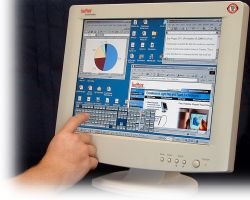Resistive LCD Touch Screen Monitors
 Over the years, LCD touch screen technology has evolved and changed. Originally hampered by limitations in screen resolution and slow
response rate, LCD touch screens have made huge technological strides to gain momentum as the touch device
of choice for many input-intensive computer applications. This site will
explain the features of one of the latest of such technologies, resistive touchscreens.
Over the years, LCD touch screen technology has evolved and changed. Originally hampered by limitations in screen resolution and slow
response rate, LCD touch screens have made huge technological strides to gain momentum as the touch device
of choice for many input-intensive computer applications. This site will
explain the features of one of the latest of such technologies, resistive touchscreens.
Most of today's touch screen systems are composed of a sensor unit attached to the main display
unit, the monitor. This sensor unit uses a hardware controller and software device driver
to sense a user's touch. The location, or coordinates, of the touch input is then determined and
relayed to the computer's operating system. For resistive touch screen flatpanels, these sensors
are connected between the monitor and the serial or USB port of the user's computer.
Resistive touch screen technology possesses many
attributes that make it more advantageous than other touch screen technologies. As a result, it is ideal
for many touch screen applications, such as desktop,
rackmount, and open-frame.
Site Map
CS-420 Project by Fred Walker
E-mail: freddywal@yahoo.com.
Photos courtesy of FastPoint Technologies.
 Over the years, LCD touch screen technology has evolved and changed. Originally hampered by limitations in screen resolution and slow
response rate, LCD touch screens have made huge technological strides to gain momentum as the touch device
of choice for many input-intensive computer applications. This site will
explain the features of one of the latest of such technologies, resistive touchscreens.
Over the years, LCD touch screen technology has evolved and changed. Originally hampered by limitations in screen resolution and slow
response rate, LCD touch screens have made huge technological strides to gain momentum as the touch device
of choice for many input-intensive computer applications. This site will
explain the features of one of the latest of such technologies, resistive touchscreens.